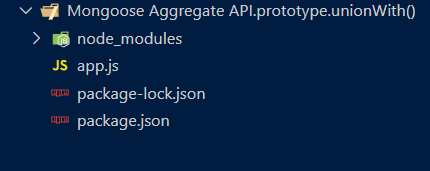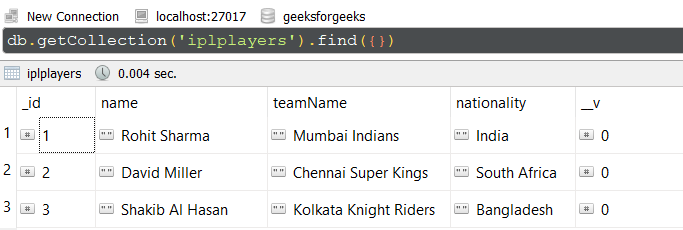Mongoose 聚合操作的prototype.unionWith()函数
聚合操作的Aggregate API.prototype.unionWith() 方法用于执行聚合任务。 它允许我们将两个集合的管道结果组合成一个单一的结果集。然而,它也允许结果集中存在重复值,但是顺序没有指定。
语法:
aggregate.unionWith( options )
参数: 此方法接受一个参数,如上所述,具体讨论如下:
- options: 它接受一个包含两个参数的对象,其中包括你想要执行联合操作的集合名称和管道数组。
返回值: 此方法以数组形式返回一个合并的结果集。
设置Node.js应用程序:
步骤1: 使用以下命令创建一个Node.js应用程序:
npm init
步骤2: 创建NodeJS应用程序后,使用以下命令安装所需的模块:
npm install mongoose
项目结构: 项目的结构将如下所示:
数据库结构: 数据库的结构将如下所示,以下文档存在于集合中。
示例1: 在这个示例中,我们使用mongoose建立了一个数据库连接,并定义了一个cricketerSchema的模型 ,其中有三列或字段“_id”、“name”和“nationality”。我们还定义了另一个模式iplPlayerSchema, 其中有四列或字段“_id”、“name”、“teamName”和“nationality”。 最后,我们使用 aggregate() 方法在Cricketer模型上选择“nationality”和“_id”字段,并将其存储在aggregate变量中。 在这个aggregate变量上,我们访问了unionWith()方法,它的参数中我们发送了另一个集合的名称来执行union操作并获取一个合并的结果集。
文件名:app.js
// Require mongoose module
const mongoose = require("mongoose");
// Set Up the Database connection
mongoose.connect("mongodb://localhost:27017/geeksforgeeks", {
useNewUrlParser: true,
useUnifiedTopology: true,
});
const cricketerSchema = new mongoose.Schema({
_id: Number,
name: String,
nationality: String
});
const iplPlayerSchema = new mongoose.Schema({
_id: Number,
name: String,
teamName: String,
nationality: String
});
const Cricketer = mongoose.model('Cricketers', cricketerSchema);
const IplPlayer = mongoose.model('IplPlayers', iplPlayerSchema);
const aggregate = Cricketer.aggregate(
[{ project: { nationality: 1, _id: 0 } }]
)
aggregate.unionWith({
coll: "iplplayers",
pipeline: [{project: { _id: 0, nationality: 1 } }]
}).then(result => {
console.log(result)
}).catch(err => {
console.log(err)
})
运行程序的步骤: 从项目的根目录执行以下命令来运行应用程序:
node app.js
输出:
[
{ nationality: 'India' },
{ nationality: 'Australia' },
{ nationality: 'England ' },
{ nationality: 'India' },
{ nationality: 'South Africa' },
{ nationality: 'Bangladesh' }
]
示例2: 在这个示例中,我们将从两个集合中获取所有字段,并将它们合并到一个结果集中。要实现这个目标,我们只需要向 unionWith() 方法提供“coll”值。
文件名:app.js
// Require mongoose module
const mongoose = require("mongoose");
// Set Up the Database connection
mongoose.connect("mongodb://localhost:27017/geeksforgeeks", {
useNewUrlParser: true,
useUnifiedTopology: true,
});
const cricketerSchema = new mongoose.Schema({
_id: Number,
name: String,
nationality: String
});
const iplPlayerSchema = new mongoose.Schema({
_id: Number,
name: String,
teamName: String,
nationality: String
});
const Cricketer = mongoose.model('Cricketers', cricketerSchema);
const IplPlayer = mongoose.model('IplPlayers', iplPlayerSchema);
const aggregate = Cricketer.aggregate()
aggregate.unionWith({ coll: "iplplayers" })
.exec((err, result) => {
if (err) {
console.log(err)
} else {
console.log(result)
}
})
运行程序的步骤: 从项目的根目录执行以下命令来运行应用程序:
node app.js
输出:
[
{
_id: 1, name: 'Virat Kohli',
nationality: 'India',
__v: 0
},
{
_id: 2,
name: 'David Warner',
nationality: 'Australia',
__v: 0
},
{
_id: 3,
name: 'Ben Stokes',
nationality: 'England ',
__v: 0
},
{
_id: 1,
name: 'Rohit Sharma',
teamName: 'Mumbai Indians',
nationality: 'India',
__v: 0
},
{
_id: 2,
name: 'David Miller',
teamName: 'Chennai Super Kings',
nationality: 'South Africa',
__v: 0
},
{
_id: 3,
name: 'Shakib Al Hasan',
teamName: 'Kolkata Knight Riders',
nationality: 'Bangladesh',
__v: 0
}
]
参考: https://mongoosejs.com/docs/api/aggregate.html#aggregate_Aggregate-unionWith
 极客教程
极客教程
